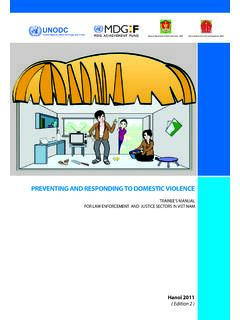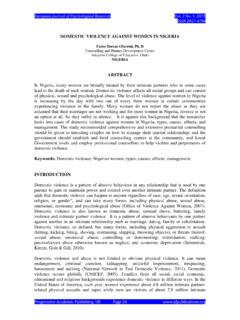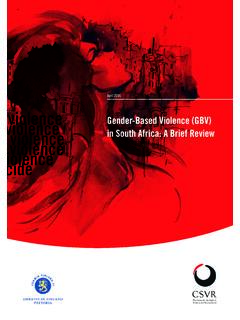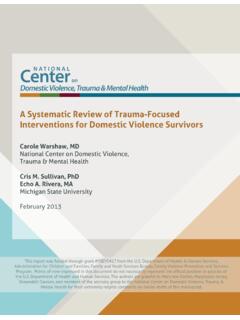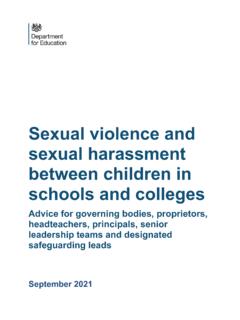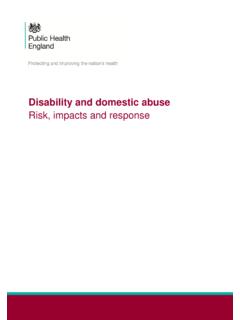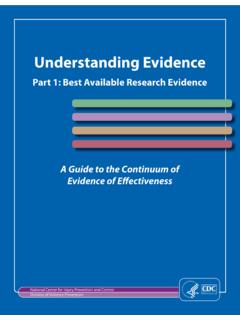Transcription of Ending Violence Against Women and Children in the Philippines
1 Ending Violence Against Women AND Children IN THE PHILIPPINES1 Ending Violence Against Women AND Children IN THE PHILIPPINESOPPORTUNITIES AND CHALLENGES FOR COLLABORATIVE AND INTEGRATIVE APPROACHESENDING Violence Against Women AND Children IN THE PHILIPPINES2 ACKNOWLEDGEMENTS This report was commissioned by the UNICEF East Asia and the Pacific Regional Office, the UNFPA Asia and Pacific Regional Office and the UN Women Asia and Pacific Regional Office as one of four country studies (Cambodia, the Philippines , Papua New Guinea and Viet Nam) and a regional paper. This report was compiled by consultants An k Gevers and Emma Day in 2018 publication has been funded by the Government of Australia through the Department of Foreign Affairs and Trade. The researchers are grateful to all of the participants who gave freely of their time to share their knowledge and experiences with the researchers on this complex topic.
2 We appreciate the efforts of the Philippines country offices of UNICEF, UN Women and UNFPA for coordinating the mission, including all meetings and follow up questions. UNICEF East Asia and the Pacific Regional Office, 2020 Permission to copy, disseminate or otherwise use information from this publication is granted so long as appropriate acknowledgement is : The views expressed in this publication are the authors alone and are not necessarily the views of the Government of shown in the photos are not necessarily survivors of gender-based Violence or child abuse. No images that identify survivors have been citation: UNICEF East Asia and the Pacific Regional Office, UNFPA Asia and Pacific Regional Office, and UN Women Asia and Pacific Regional Office, Ending Violence Against Women and Children in the Philippines : Opportunities and Challenges for Collaborative and Integrative Approaches, Bangkok: UNICEF, photo credit: UNICEF/UN0296813/Noorani UNICEF East Asia and the Pacific Regional Office19 Phra Athit RoadBangkok, Thailand 10200 Email.
3 Violence Against Women AND Children IN THE PHILIPPINES3 CONTENTSD efinition of key concepts 4 Abbreviations and acronyms 4 Executive summary 5 Background 5 Key research questions 5 Key findings 5 Recommendations 8 Introduction 9 VAC and VAW in the Philippines 9 Mandate of United Nations agencies 10 Methodology 10 Key research questions 10 Research methodology 11 Findings 11 VAC and VAW agenda and priorities in the Philippines 11 Government structure, policy and legislation 14 Access to justice 16 Response and support services 19 Prevention programming 23 Adolescents 24 Integration 24 Recommendations 25 Annex 1: Stakeholder meetings 26 Ending Violence Against Women AND Children IN THE PHILIPPINES4 Violence Against Children (VAC) refers to all forms of physical or mental Violence , injury or abuse, neglect or negligent treatment, maltreatment or exploitation, including sexual abuse Against any person under age 18 (United Nations Convention on the Rights of the Child, 1989).
4 Violence Against Women (VAW) refers to any act of gender-based Violence that results in, or is likely to result in, physical, sexual or psychological harm or suffering to Women , including threats of such acts, coercion or arbitrary deprivation of liberty, whether occurring in public or in private life (Declaration on the Elimination of Violence Against Women , 1993). In general, the term Women is assumed to refer to females of all ages. Some institutions specify a focus on Violence Against Women and girls (VAWG) to emphasize the inclusion of girl Children in their work on civil society organizationDSWD Department of Social Welfare and DevelopmentGAD gender and developmentIACVAWC Inter-Agency Council on Violence Against Women and their Children NGO non-governmental organizationUN United NationsUN Women United Nations Entity for Gender Equality and the Empowerment of WomenUNFPA United Nations Population FundUNICEF United Nations Children s FundVAC Violence Against childrenVAW Violence Against womenVAWG Violence Against Women and girlsWCPD Women and Children Protection Desk in police stationsWCPU Women and Children Protection Unit WHO World Health Organization DEFINITION OF KEY CONCEPTS ABBREVIATIONS AND ACRONYMSENDING Violence Against Women AND Children IN THE PHILIPPINES5 EXECUTIVE SUMMARYB ackgroundWhile the fields working to end VAC and VAW have largely
5 Developed separately, recent reviews and analyses of large datasets have identified multiple intersections between VAC and VAW including: co-occurrence, shared risk factors, similar underlying social norms, common consequences, intergenerational effects, and the period of adolescence as unique period of heightened vulnerabilities to both types of Violence . These intersections suggest that collaboration between the sectors is essential to a more effective prevention and response. Integration of certain aspects VAC and VAW prevention and response across services, programmes, and policies may also be advantageous. However, there are key areas of divergence between the traditional approaches in the VAC and VAW fields that have created challenges to collaboration and may suggest some disadvantages to fully integrative approaches.
6 To date there are no evidence-based or widely accepted integrative models. This multi country study, commissioned by UN Women , UNICEF and UNFPA, explored existing examples of collaboration and integration of VAC and VAW policies, services, and programmes, as well as challenges and future opportunities in the East Asia and Pacific region, with a focus on four countries Cambodia, Papua New Guinea, the Philippines , and Viet research questionsThis research initiative sought to answer following overarching questions through dialogues and interviews with relevant stakeholders in each country: 1. What are the existing VAW and VAC policies, action plans, programmes (prevention) or services (response/support)? 2. What are some examples of policies, action plans, programmes, or services where there is some evidence of VAW and VAC integration ( : addressing both VAW and VAC at the same time)?
7 Include any efforts to try to develop cohesive strategies or plans or collaboration. 3. How do VAW-focused and VAC-focused stakeholders collaborate or interact? How do donors drive the VAW-VAC agenda? 4. What are the areas of tension between VAC and VAW work? How do various stakeholders address areas of tension between VAW and VAC? a. Under what circumstances are boy- Children accommodated in places of safety? b. How are adolescents complex needs met and rights protected? c. How are mothers viewed and processed in VAC cases? 5. What are some opportunities within the existing policies, action plans, programmes or services where integration and/or collaboration could be introduced or enhanced?Key findingsViolence Against Children (VAC) and Violence Against Women (VAW) affect the lives and welfare of millions of people around the world.
8 Many Women and Children in the Philippines suffer multiple types of Violence . The multiple negative sequelae of this Violence can be long-lasting throughout the lifespan and across generations as well as impacting on individuals, relationships, communities, and broader society. Agenda and priorities The Philippines has good quality national prevalence data on some forms of VAW and VAC; however, administrative data are poorly coordinated thus not allowing for a holistic picture to understand gaps between national prevalence and service delivery. There is no mechanism to ensure national prevalence data on VAC are regularly collected. VAW data is regularly obtained from the National Demographic and Health Survey. While there are no data or studies to date on VAW-VAC intersections in the Philippines , stakeholders are aware of various important Ending Violence Against Women AND Children IN THE PHILIPPINES6intersections in vulnerabilities.
9 Structured data collection protocols or studies would provide useful evidence for policy and programming. Improved access to and analysis of reliable data, as well as dissemination of findings, could assist in strategic funding or budget guidelines for the gender and development budget and the child protection budget. Government, legislation and policy Multiple government departments have a role in both VAC and VAW and serve on the Inter-Agency Council on Violence Against Women and Their Children (IACVAWC): Department of Social Welfare and Development (DSWD), Department of Interior and Local Government, Philippine National Police, Department of Justice, Department of Health, Department of Education, Department of Labor and Employment, Civil Service Commission, Commission on Human Rights, Council for the Welfare of Children , National Bureau of Investigation, and National Commission on the Role of Filipino Women .
10 This committee did not appear to drive specific integration efforts. The Philippine Commission on Women is the primary policy-making and coordinating body on Women s empowerment and gender equality. The Philippine Plan of Action to End Violence Against Children includes roles for DSWD, the Department of Education, Department of Justice, Council for the Welfare of Children and the Department of Interior and Local Government. The main pieces of legislation applicable to VAC and VAW are Anti Child Abuse Law (RA 7610), Anti-Rape Law (RA 8353), and Anti- Violence Against Women and their Children Act of 2004 (RA 9262). While there are councils and committees set up to address VAC and VAW and many service providers see both VAC and VAW survivors, there are no formal integration policies or programming guidelines.










